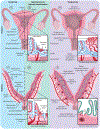Mechanisms of Regeneration and Fibrosis in the Endometrium
- PMID: 37843929
- PMCID: PMC11444732
- DOI: 10.1146/annurev-cellbio-011723-021442
Mechanisms of Regeneration and Fibrosis in the Endometrium
Abstract
The uterine lining (endometrium) regenerates repeatedly over the life span as part of its normal physiology. Substantial portions of the endometrium are shed during childbirth (parturition) and, in some species, menstruation, but the tissue is rapidly rebuilt without scarring, rendering it a powerful model of regeneration in mammals. Nonetheless, following some assaults, including medical procedures and infections, the endometrium fails to regenerate and instead forms scars that may interfere with normal endometrial function and contribute to infertility. Thus, the endometrium provides an exceptional platform to answer a central question of regenerative medicine: Why do some systems regenerate while others scar? Here, we review our current understanding of diverse endometrial disruption events in humans, nonhuman primates, and rodents, and the associated mechanisms of regenerative success and failure. Elucidating the determinants of these disparate repair processes promises insights into fundamental mechanisms of mammalian regeneration with substantial implications for reproductive health.
Keywords: Asherman syndrome; intrauterine adhesion; menstruation; parturition; pregnancy; stem cell.
Figures



References
-
- AAGL (Am. Assoc. Gynecol. Laparosc.). 2017. AAGL practice report: practice guidelines on intrauterine adhesions developed in collaboration with the European Society of Gynaecological Endoscopy (ESGE). J. Minim. Invasive Gynecol 24:695–705 - PubMed
-
- Acosta Go V-A, Ibrahim Y. 2022. Schistosomiasis induced Asherman’s syndrome in a patient undergoing assisted reproductive technology (ART): a case report and literature review. Fertil. Steril 118:e199
Publication types
MeSH terms
Grants and funding
LinkOut - more resources
Full Text Sources

